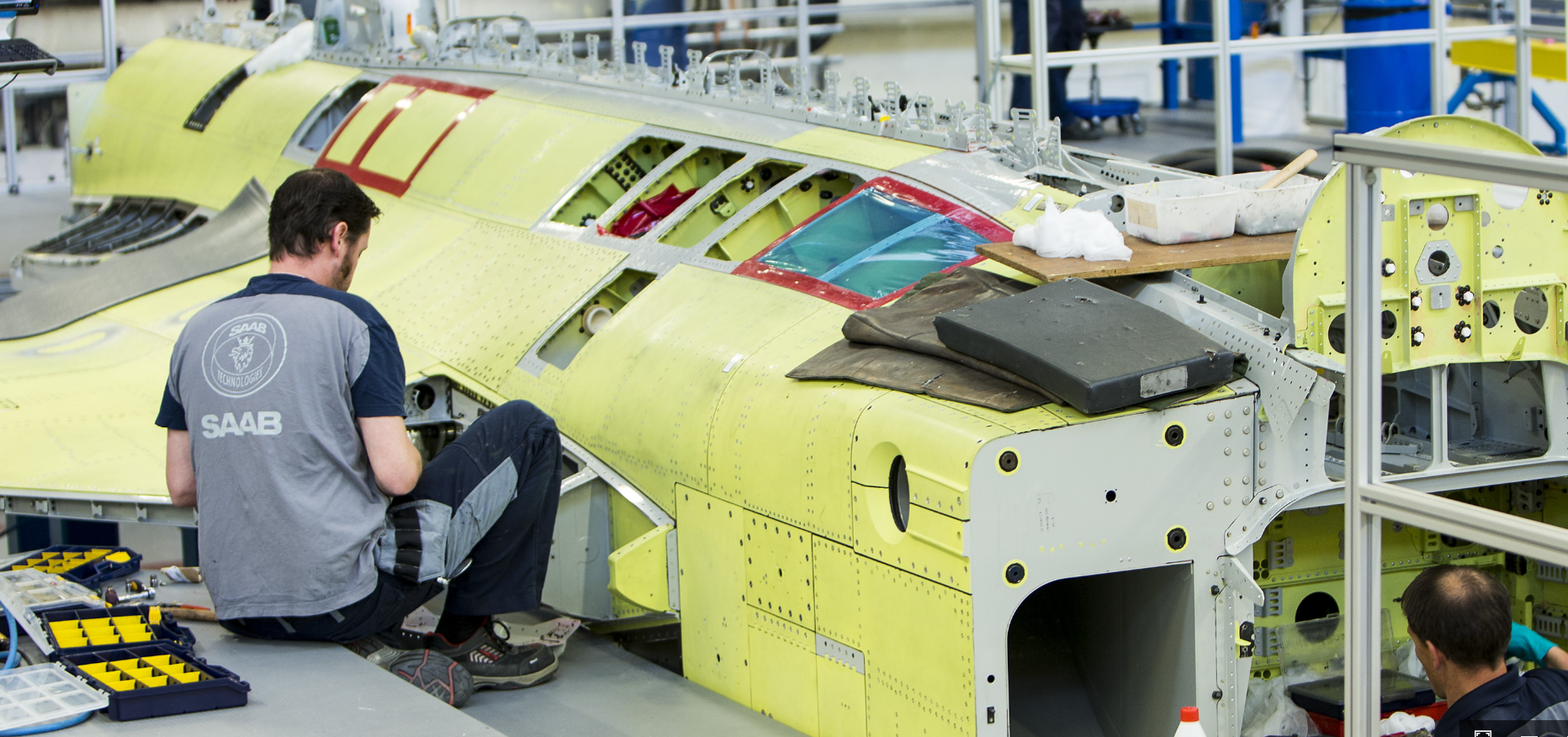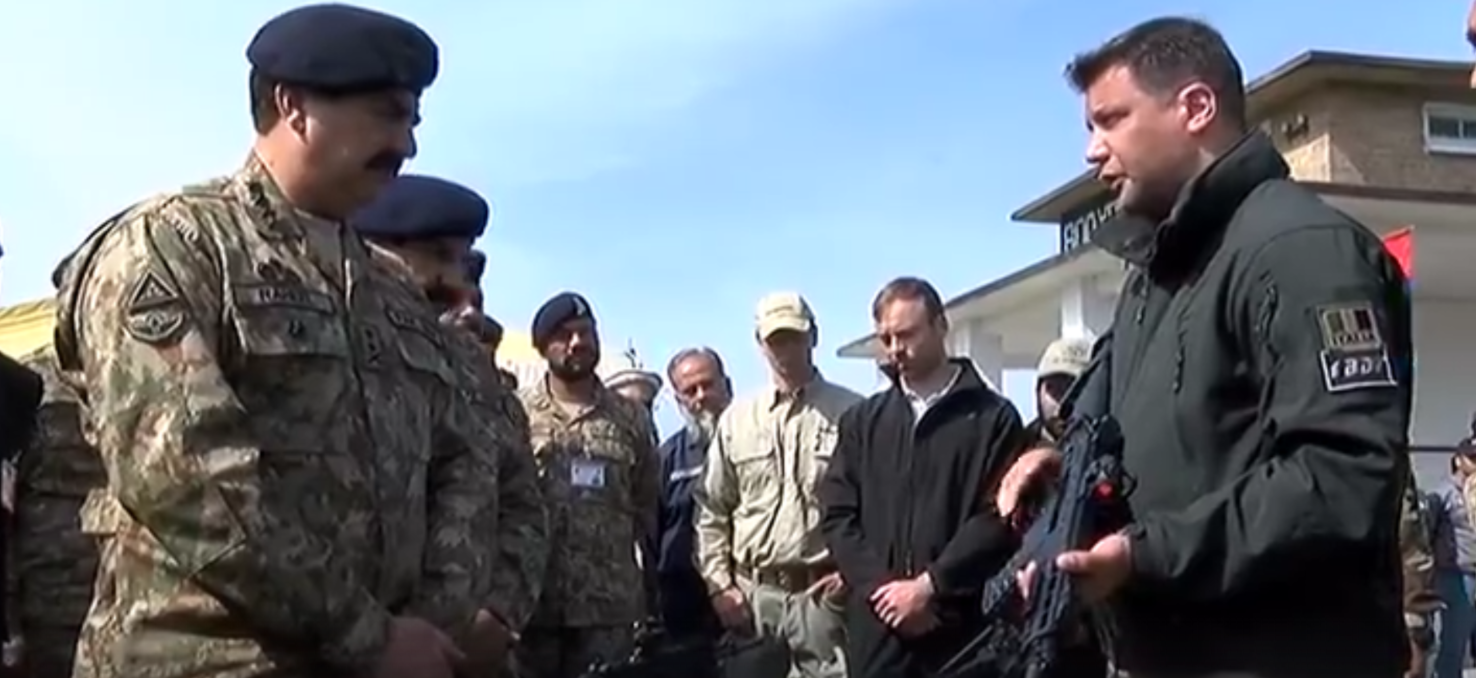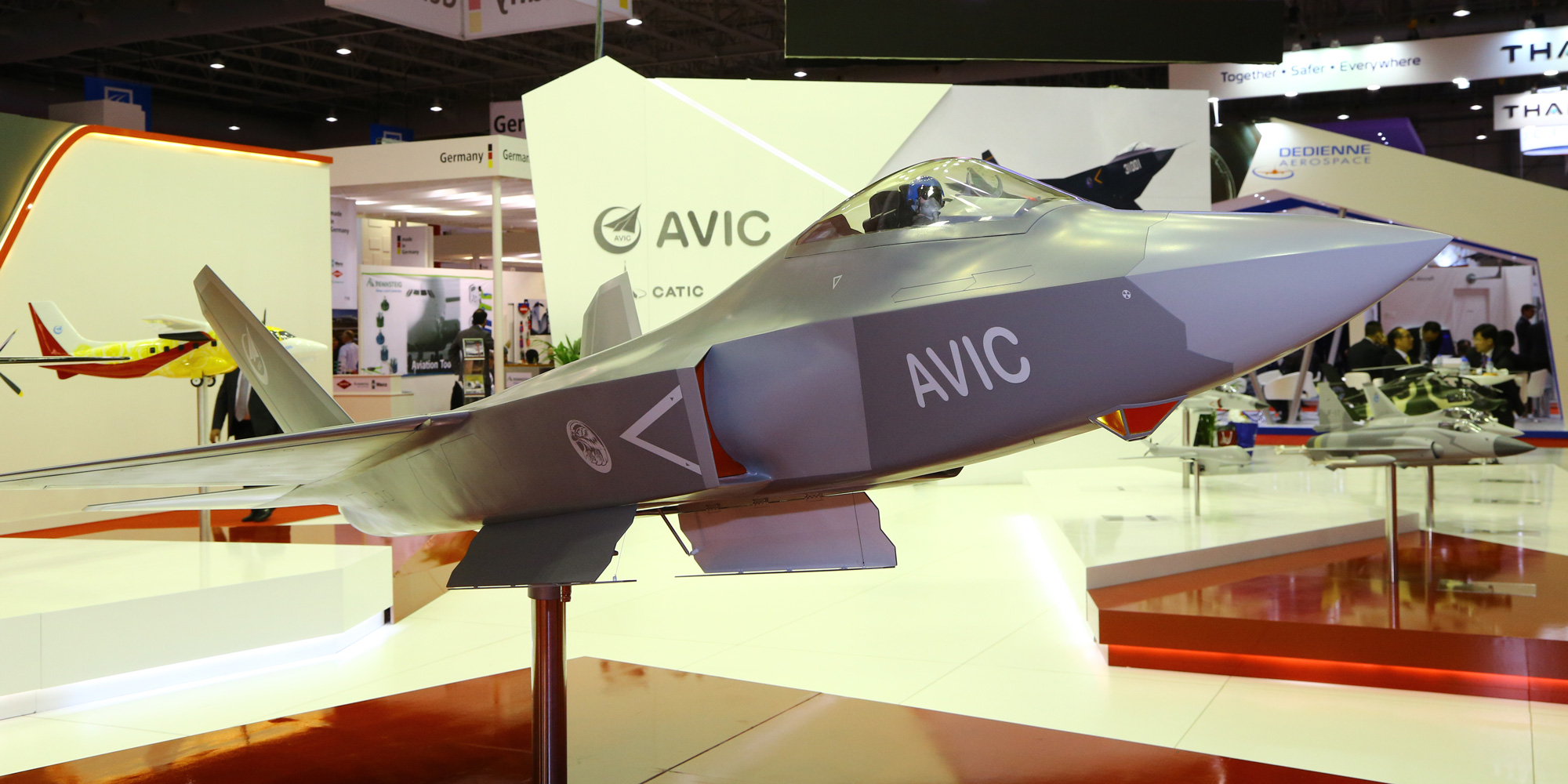2527Views 32Comments

Indian Air Chief visiting Saab
The Indian Air Force (IAF) Chief of Air Staff (CAS) Air Chief Marshal (ACM) Arup Raha is currently visiting Sweden, specifically Linköping where the Saab JAS-39 Gripen is being produced.
With the Rafale deal set to be finalized this month and the IAF still in need of new fighter aircraft to rectify its quantitative drop, Saab is looking to emerge as the answer.
Under the ‘Make in India’ program, Saab is offering India to produce the JAS-39E/F Gripen (also known as the Gripen Next Generation or NG) under license.
The IAF on the other hand is looking to loop Saab into the Hindustan Aeronautics Limited (HAL) Tejas, which is envisaged to replace the IAF’s legacy MiG-21s and form the backbone of its lightweight fighter fleet. It is hoped that Saab would provide technical expertise and assistance for the forthcoming Tejas Mk-II, which will be equipped with an active electronically-scanned array (AESA) radar.
Comment and Analysis
The Indian Air Force (IAF) may be at a crossroads. Saab’s primary incentive is to acquire a major buyer for the JAS-39E/F, and India would be the perfect fit.
Not only is the IAF seen as a major prospective buyer (in that it can acquire a large number of Gripens), but India’s manufacturing base makes commercial offsets an attractive proposition for Saab.
Saab can basically use India to scale the Gripen’s adoption and to build a cost-competitive supply-channel for spare parts, maintenance repair and overhaul (MRO), and of course production. For Saab, the benefits extend beyond simply India, they could be scaled to prospective customers globally by enabling Saab to offer much more competitive Gripen packages.
The sticking point to this plan is the IAF and its current willingness to persist with the Tejas program. The IAF wants Saab’s expertise, which in turn can be used to develop the Tejas Mk-2 – i.e. a Gripen competitor. In the best case scenario, the Tejas Mk-2 would close the IAF’s lightweight fighter requirement, but the worst case scenario would be to see the Tejas Mk-2 being exported to Saab’s clientele.
It will be interesting to see how this is managed by both sides. Between the Tejas and Gripen, one program would simply have to go, and Saab understands that its maximum interim and long-term gains come from selling the Gripen to India.
For India, closing the Tejas would mean settling for a program that has served as a technology demonstrator, albeit an incredibly valuable one considering the achievements India made in terms of aircraft design and manufacturing.
Granted, the IAF could induct both platforms, but operating a large number of diverse aircraft, and that too of multiple origins, is a massive cost and liability in its own right.



32 Comments
by Abdul Rashid
=> MT II comment on ↑ article 4 the enlightenment of all ↑ & ⇩ this > comment <<<.
by jigsaww
Lol.
by rtnguy
India has already started inducting tejas Mk1 and Tejas MK1A. The MK1A is is same as Mk1 with slightly lighter weight and AESA. So now tejas programme should be closed and focus should be on AMCA. As for MK2, it will take another decade to come to fruition and best is to go for Grippen NG.
by jigsaww
Gripen E is one expensive jet to buy or make in Hindustan. It’s new. Tech is expensive and expected ToT will never take place. Will take too long to breakeven and with Hindustani penny pinching mindset, profits will be low for Saab. Then If Rafale haggling is any sign, there are no funds to fund rafale or similar high tech purchases, such as S400. Gripen E will only make things worse, be it local production or off the shelf buy. HIndustan is in no position to replace 300 fighter jets with off the shelf purchases in matter of 5 years. Neither is the budget/economy well enough to start local production of Gripen E type fighter. It will cost them as much as Rafale at the end of the day. Raha is not there to talk about Gripen E. Hindustan will never go for it and Sweden will not extend substantial support otherwise. Hindustan is only looking to flirt with swedes and get them to fix Tejas while signaling the false intention of Gripen which it will never commit to.
At present, there is no aircraft manufacturer ready to make Tejas work because of the drama hindustan has faked around MMRCA for last one decade. Russians, French, Swedes, Italy, everyone is cautious of entering deals with hindustan and would only like to sell on cold hard cash which hindustan does not have, no matter what you hear.
Whatever relief may come will come from US on local production of F-18 which has recovered its R&D and other costs over time and is on verge of replacement in world air forces. This is the only viable and potentially happening production for Hindustan.
by Hindukkush
So far the Tejas project has added up to zero operating squadrons……..lets see if India can improve on that by beg steal or borrow route
by Hindukudh
You might have hit the nail on the head……there are some chess players on the right side of border too who can think about the next 5 moves and counter moves
by jigsaww
Yeah i guess now you have taken over from the “poor management”. It’s destined to advance quickly now from a little hiccup of 40 years delay in Tejas.
Don’t keep the world waiting.
by jigsaww
There isn’t a single defence article produced in Hindustan that was created without “begging” for foreign technical support, funded in some way by USAID or foreign loans, or stolen by stealing designs or technology.
by Abdul Rashid
Go and check out the Gripen NG if possible while you are still in Sverige!
by MT
Drdo/Hal are working on tejas mk1a with some consultation from swedes engg & israeli who r helping hal with aesa radar integration.
Hal needs saab engineers so its good to flirt with swedes for time being.
Brazilian r paying big money to get TOT of gripen which is coming around 150-175 mill $ while SWEDES don’t make the plane even with 50%local component so it’s futile for india to buy gripen.
From some sources there are rumour of HAL pickings minority stake in saab which ll provide india with technology in scaling up mk1a to 4+/4.5 gen mk2
India have got a ok bargain on rafale with 33% offset so tejas mk2 ll absorb many french,israeli technology & pick up some features of gripen e/f.
For time being ; indian acquisition budget can’t afford anything more than rafale so we have to wait for 2-3yrs for F18/gripen.
But F18 makes more sense for india with boeing ready to invest in india if iaf orders 80-90
by Quraishi
Haha u just cannot talk to someone u cannot categorize can u?
by jigsaww
@Quraishi. I asked you to justify a budget with YoY inflation, increasing ops costs, maintenance, and rising acquisition costs in the world. You come back to me with boy’s speech how he’s been mistreated and whatnot…
I’m not interested in how bad you feel because your little feelings have been hurt. I want to know how you propose Pakistan cutting down on its military budgets vis a vis major military ops taken in the country and rising expenditures because of flight of capital and inflation in the country. You didn’t give any solution what i see. And no, please don’t ask others who they are if YOU are not ready to tell about yourself…and it’s not about the race, you were never in the race.
Also, please try to write in understandable English. I cannot read your comment half a dozen times to “comprehend” your infinite intellect.
What i see is that there’s more hindustani appreciating your comments than pakistanis. i think there is a reason to that.
@SalmanKhan. Since time ran out on other thread.
You sound more like a political nooni jiala to me than anything logical otherwise. And i think i might have pulled a nerve or two by hitting on the incompetent gov. So i’m going to make it worse for you. Get this right now. I’m not PTI. I have not voted for any political party ever in my life, part of that is because i’m on the move all the time. I do not think imran khan is the answer but i think he’s way cleaner than nawaz and Nawaz is the curse on this country. Nawaz is corrupt and he has no stake in Pakistan. He is a crook and sorry, i don’t care how bad you feel about it too. You probably feel he is the ameer ul momineen but don’t forget he is creation of same military. He has no achievement of his own. His brother is a thug. Neither do i support military take over. I am a civilian. I have nothing to do with military. I’ve said what needs to be said about army’s needed role, you just have been absent. I think all problems pakistan is in today post 911 are because of musharraf’s policies…so don’t go all hasty riding your horses…btw…you quoted me somewhere about pakistan’s economy doing best in musharraf’s era…at least do your homework right..because whatever he may be…pakistan WAS declared best reformer in 2005 and the economy was actually way better than what it is now…i think you have to be only a jiala to not see that…anyway…i’m not interested in your political views here…
by little children
you are welcome to give examples….US doesn’t give India defence AID. lol…maybe you are talking about pakis who stole missile blueprint from North Korea and can’t even pay full money for an F-16s
by Sami Shahid
J-10 for pakistan
by jigsaww
I’ve told this many times to your fellow citizens. Apparently your delusions do not let you acknowledge it.
http://timesofindia.indiatimes.com/world/us/India-top-recipient-of-US-economic-aid/articleshow/48093123.cms
Hindustan is biggest recipient of USAID in all of its 66 years history.
So, as you can see. No. I am talking about Hindustan.
by jigsaww
Do you have something constructive to add here or is it all about Mohalla talk and taunts? I do not care about how bad you feel about me saying what i feel is truth.
I asked you a question. It’s the third time i am asking you. And i need you to respond to it logically. With Pakistan seeing an almost 4% YoY rise in inflation, military acquisition costs rising, Pakistan losing 200 billion USD in WoT, its military taking major clean up ops in country in last one decade, security of CPEC and raising of new SSG and security units, how do you propose cutting down on military budgets when no major country in the world has actually reduced its military budget. Give Pakistan a working solution.
If you do not have a logical answer to my questions, take your Mohalla taunts somewhere else and please do not respond to me. Also, let other people talk about their own self. Keep yourself confined to your arguments. Thank you.
by Syed
Don’t like that paki word it’s derogatory it’s similar to using the word Dothead for Indians or Hindus
by Abdul Rashid
Hi Syed. I had edited out the same derogatory abbreviation in a previous comment. Sorry slipped through this time, I have made the necessary edit now.
by Abdul Rashid
I’m curious to know what “jiala” means? I found several diverse definitions on the internet but nothing definitive.
by jigsaww
I think this should help.
http://www.dawn.com/news/683564/the-jiyala-a-political-and-spiritual-history
In short, die hard political fans or workers.
As apparent, this was nothing to do with Imran khan, but as it goes with every nooni, everyone opposing ameer ul momineen hazrat nawaz (RA) is a PTI guy.
by Abdul Rashid
Nothing ever sticks to Nawaz, the Teflon Man. All accusations, allegations of fraud, charges of corruption, you name it. Hair even. No matter what is thrown at him it all slides off.
by jigsaww
Apparently they don’t even stick to his jiala supporters.
Whatever happened to Pakistanis. Can’t even speak and stand truth.
by Quraishi
I did well answered ur question, such decisions r not made based on feelings and assumptions, if u think u can then that’s more stupid then u think.
Again when when did I say it should be less, u don’t u get this point.
Y do u think that I feel bad about what ur saying, ask others here what they feel about what u have written compared to what I have written, ur like a frog in a well, ur just saying the same thing again and again, how can u talk to someone and u don’t even understand what they r saying.
And I don’t know how many times I have to repeat, I never said the budget should be reduced. I never said there’s no solution, what I said was there can be better strategy.
What ur saying is nothing close to logic,
by Abdul Rashid
Cool. I can go and see F-35 at the Farnborough Air Show next month but not too sure if I’m going to bother. JF-17 is not on display this time as far as I know.
by jigsaww
STOVL version is coming of F-35.
I think PAF will restart their JF-17 campaign with block 3. They’re focusing on getting that out. Block 2 might be done with airshows.
by jigsaww
Again, you deflected away from the question I put to you.
Right!
by Quraishi
People can read this reply above and know y Pakistan is considered a third world country.
The person has no clue on what’s going on, he’s like hey let’s be cool, increase it to 11billion see how much I love my country haha
Go live in ur fantasy world
Get anyone else to read my posts and urs , perhaps one of ur friends and who u consider to be an intelligent person and see his response.
by jigsaww
Good now that you have successfully switched back to your original argument of “Pakistan’s defence budget increase being stupid”. you now need to support your argument WHY Pakistan does NOT need to increase its budget, even while all security challenges see the need for it as i have explained.
by Quraishi
I never said the increase is stupid , I said the strategy seems to be lacking, I was never primarily concerned with the budget. U fail to understand what I’m saying
by Abdul Rashid
Thanks for the link. An eye-opener (for me). Serves to remind me once again how little I know about the political culture of Pakistan and the need for caution when commenting on the Saints, oops sorry I mean party leaders. Do not want to offend people. I think Cameron is doing a great job in UK but I’m not yet quite a Conservative Party jiyala, lol.
by Syed
Qureshi pardon my Urdu but aap Baal ki Khal nikal rahey ho.is there a method to your madness or are you just showing off your English skills.
by Quraishi
I didn’t
It’s u who didn’t even come close to answering any of my Qs